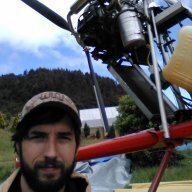-
Posts
23 -
Joined
-
Last visited
Information
-
Location
Chile
-
Country
Chile
Byron's Achievements

Member (1/3)
-
Thanks, I can't believe this overflow bottle was used. Does it come this way from the factory? I expected it to fill up with coolant when I turned the motor off. Should I add some room temp coolant next time?
-
Not sure of the compressions, hoping to get that done Tuesday. No risk of old fuel. Brand new fuel in the lines since I replaced them. What is a leak down. Could you provide a link or is this in the maintenance or heavy maintenance manual. I have both downloaded
-
Here is a video I took today. This engine has made this hissing sound out of cylinder #1 ever since I bought it. Would a leaking head gasket cause this? Overflow bottle had pressurized I guess and blew a hole out the bottom. Oil leak cylinder #1 Small leak cylinder #2 Cream and water residue on oil cap and in reservoir
-
Thanks for the suggestions and advice...great stuff. I have a mechanic I know coming tuesday to give it all a look. He has a license to work on small aircraft engines but is currently working on commercial aircraft. I will print out all the comments and show him, I think they are some good ones.
-
Thanks for the suggestions and advice...great stuff. I have a mechanic I know coming tuesday to give it all a look. He has a license to work on small aircraft engines but is currently working on commercial aircraft. I will print out all the comments and show him, I think they are some good ones.
-
How can I find out more about how to check if the radiator is pressurising? What will this determine? It all gets pretty clean?
-
I have double triple checked the diaphragm and the are seated great and the dimple is lined up. Checked the piston too. Very smooth...there is a green color one the need tip about 1/2 covering the tip. I will digest the other received comments too. Good stuff
-
Well here is an update: I looked in the oil reservoir this morning and found my worst fear. White cream on the bottom of the lid. Looks like a blown head gasket:crying: I'm licking my wounds and looking for a head gasket set. If anyone has a link to purchase one let me know. Don't know how this happened. You may send your condolences
-
Needing full choke for the engine to run without roughness or power loss is a new problem since the installation of the new parts. That is what is so strange. I think a fuel pressure test and good balancing is a start. I just thought maybe it could be a simple fix since it was running great before. Definitely seems to be a fuel starvation problem. Anymore thoughts or suggestions?
-
-
Can you send me a link to the required length of the carb float vent line. I just looked through the installation manual and it just discussed diameter of tubing and avoid placing the end of the tube in a slip stream. Requirements on the drainage piping: NOTICE With closed or blocked leakage piping, fuel could end ƽWARNUNG up on exhaust system. RISK OF FIRE! - The lines have to be routed such that in case of damage the surplus fuel is drained off suitably. - Route the lines without kinks and avoid tight bends. - Route the lines with a continuous decline. - The lines have to be protected against any kind of blockage e.g. by for- mation of ice. venting lines Float chamber venting lines (1): Float chamber Connecting nip- ple for leakage line NOTICE The float chamber venting lines (1) have to be routed into a ram-air and vacuum free zone or into the airbox, according to the requirements and release of BRP-Powertrain. See chapter “air intake system“. These lines must not be routed into the slipstream or down the firewall. Pressure differences between intake pressure and pressure in the carburetor chambers may lead to engine malfunction due to incorrect fuel supply. Connecting nipple (3) for leakage line: -Outside dia. 6 mm (1/4‘‘‘) -Slip on length Max. 17 mm (11/16‘‘)
-
I had all the oil lines off and the system was open during the oil hose change. http://www.flyrotax.com/portaldata/5/dokus/d05199.pdf SERVICE INSTRUCTION PURGING OF LUBRICATION SYSTEM FOR ROTAX® ENGINE TYPE 912 i, 912 AND 914 (SERIES) SI-912 i-004 SI-912-018R1 SI-914-020R1 1.5) Compliance These inspections have to be performed - before first engine run, - after re-installation (e.g. after overhaul), - after lubrication system opened or drained during maintenance work (e.g. removal of oil pump, oil cooler or suction line).
-
Rebalancing is a suspicion of mine also, but would get that rough if I changed the carb diaphragm and gaskets in the float bowls and chokes. Fuel pressure test might be revealing I agree.
-
I double tripple checked the fuel line assembly mick, looks all correct. This system doesn't have a return line. Here are some pics
-
Interesting idea. It seems plausible. But 4 months ago, before all the new parts mentioned were replaced. The engine sounded beautifully. I will definitely check the carb mount rubbers in a few hours when the sun rises.













